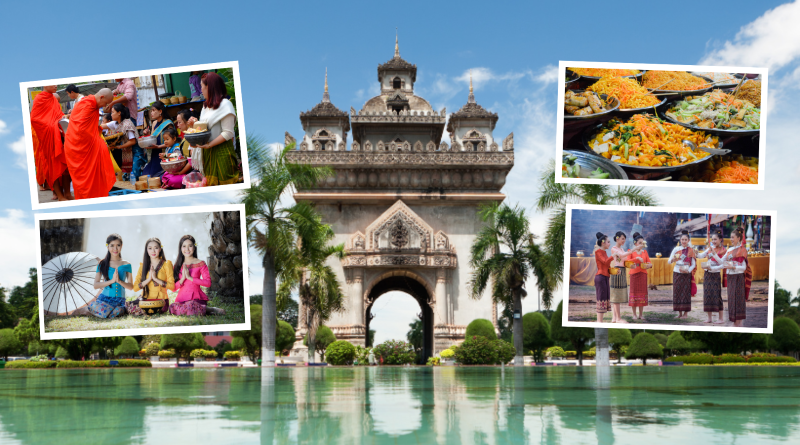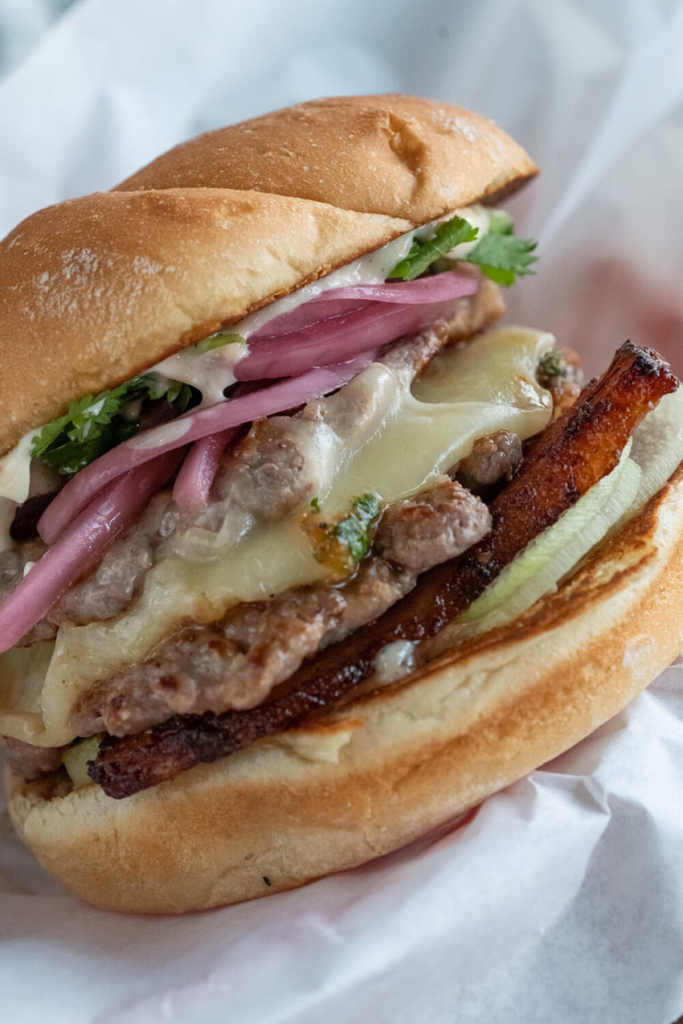Laos: Hidden Gem of Southeast Asia, Shines Bright with Food, Culture, and Arts
Source: NorthWest Asian Weekly
Forty years later, it’s a very exciting time for the Lao diaspora, shared Dennis Sikhanthat, creative director of Pom Foundation.
Though Laos is a small country with about 7.5 million people, more and more people are starting to recognize its food.

Lao Food Movement
Sikhanthat shared that the Lao food movement is making an impact now as Laos emerges as its own identity, breaking away from Thailand.
“A lot of Thai restaurants are owned by Lao people because of marketing. No one really knows about Laos, but more people are starting to recognize Laos which adds to the vibrancy and diversity of southeast Asian cuisine,” he said.
Something that is distinctly Lao is “gang nor mai,” which is a bamboo shoot stew. Sikhanthat said that you wouldn’t find it at Thai restaurants unless you go to an Isarn Thai restaurant.
In fact, Laos consumes more sticky rice in the world than anyone else.
“We eat sticky rice as a main dish, not just as a dessert,” Sikhanthat added.
Katherina (Kay) Vongphrachanh also agrees that Lao food has had the biggest impact on American culture so far.
“Gordon Ramsey and Anthony Bourdain have each given Lao food its praise which is pretty amazing considering most people don’t even know Laos exists as a country,” Vongphrachanh shared.
“The rise in popularity in Lao cuisine has brought the spotlight to our country more than ever before. It’s nice to see people are now familiar with our country as opposed to when I was in elementary school when no one had even heard about it,” Siriphong Keodara said.
Khampaeng Panyathong is introducing Lao food to the public at his restaurant, Taurus Ox.
“People are enjoying the food here and most guests have never eaten Lao cuisine before,” he said.
His parents were born in Laos while he and his two siblings were born in a refugee camp in Thailand. He arrived in Seattle when he was 2 years old and grew up in a Laotian household in Seattle but ate mostly Lao food and spoke the Lao language. It wasn’t until he went to school that he became familiar with American culture.
According to Panyathong, the highlights of Lao cuisine are sticky rice and jaew.
“The flavors are bold, yet balanced. The focus is on fresh vegetables and fresh herbs. We use a lot of garlic, shallot, lemongrass, lime leaf, and bird’s eye chili. We also use unique ingredients like pepper wood, Lao prickly ash peppercorn, yanang leaves, and green algae,” he said.
A traditional Lao family meal consists of sticky rice and jaew, a soup made with meat or fish with vegetables/herbs, roasted meat or fish, and fresh or steamed vegetables.
“At Taurus Ox, we highlight the sausage because my mother and I started making that in my parents’ garage for years before I opened Taurus Ox. The sausages definitely started it all. At first, only Lao people were buying them, then other Asians, then non-Asians. That’s when I realized that a Lao restaurant could potentially be successful,” he said.
“Other authentic Lao dishes at his restaurant include soop pak, chicken laap, khao poon, sticky rice with jaew tomato or jaew bong, beef jerky, and papaya salad. We also have jaew som that we put on our fresh shucked oysters and grilled beef hanger steak,” Panyathong added.
Unforgettable History
Another little known fact about Laos is that it is the most heavily bombed country in history. Over the course of nine years, from 1964 to 1973, the United States dropped the most bombs in Laos than all of World War II combined.
“It’s a lesson for human kind to be aware of: the destructiveness of war and how deceptive governments can be. American’s didn’t know this and you can learn more on YouTube if you search ‘Secret War in Laos,’” he said.
Sikhanthat added that people including children still continue to die in the rice fields and jungles of northern Laos due to those undetonated bombs.
“No one wants their country to be known as the most bombed country, but if anything, it serves as a lesson for all humankind,” he said.
“Laos is a beautiful country. It’s very green and ecotourism is a big thing there. It’s changing, it’s trying to keep up with bigger neighbors,” Sikhanthat said.
In fact, Laos was named by CNN as one of the best destinations to visit in 2023, citing its numerous sites to see including Vang Vieng and Luang Prabang.
Honoring Lao Values and Traditions
Finding community is truly a strong value in Lao culture.
Recently crowned 2023 Miss Lao Washington, Diana Thiamtisak wanted to participate in the local pageant to meet other young Lao women in the community.
Thiamtisak grew up in Atlanta, Georgia and moved to Washington state in 2016. She hasn’t been able to meet other Lao women so the pageant was a great opportunity to network. It was held by the Lao Community Services Center and one of their goals is to raise funds to create the first Lao community center in Washington state.
“Many of us weren’t born in Laos. I think Lao culture comes from our families. Family is really important—we learn from them and we can’t get that anywhere. That’s something I really like, the sense of community and togetherness,” she said.
Thiamtisak is also a part of the recently revived Lao Students Association at the University of Washington.

“Being able to connect through our culture has allowed us to find a sense of community,” she added.
Thurrey Phandanouvong hopes to pass down knowledge of Lao food and traditions down to his 5-year-old son.
Though Lao culture is still relatively unknown to Americans, Phandanouvong thinks that they are in the fringes and are making progress especially with more Lao people on TV, social media, and at festivals to celebrate Lao culture.
Respecting elders in regards to their life lessons is a huge component of Lao culture, Phandanouvong shared.
“Lao New Year is huge and the celebrations are fun because it’s such a big social gathering, but I would love for more people to understand the meaning behind the celebrations and ceremonies,” Siriphong Keodara added.
Keodara was born in a refugee camp in Thailand, but has visited Laos twice in his life and plans on going back again later this year.
He also mentioned that he’s planning to volunteer with local Lao organizations to be more familiar with the culture. But he’s appreciative of the Lao traditional ceremonies and celebrations such as Lao New Year, where they go around and bless the food and place it in different tins.
Growing Appreciation of Lao Music and Arts
Sikhanthat was born in Vientiane, Laos and moved to the United States in 1980. He is the creative director of Pom Foundation, a nonprofit whose mission is to preserve, foster, transmit, and educate about Lao arts, culture, and traditions. He is also very passionate about music and is an influencer who goes by Lao Ocean on YouTube.
He recently volunteered at the Sabaidee Fest, the largest Lao/Thai/Hmong music and cultural festival, that was held earlier this month in Norco, California.

Pop and R&B music is becoming very popular in Laos and those music videos are gaining more recognition and fame on YouTube.
“These Lao bands consisting of kids from the boonies and villages are gaining hundreds of millions of views. They’re so talented and they’re not just making one hit wonders, they’re making a string of hits,” Sikhanthat said.
In addition, Vongphrachanh would love to introduce people to the amazing arts of Laos from woodworking, metal working, embroidery, silk making, flower arrangements, and also performing arts.
“Lao culture is so rich in beautiful arts,” Vongphrachanh shared.
“It goes to show that people outside are looking in and music is an international language. There’s a great connection between Lao Americans and folks back home, as well as globally between all Lao people. It’s an exciting time for the Laos diaspora right now, 40 years later,” Sikhanthat said.




